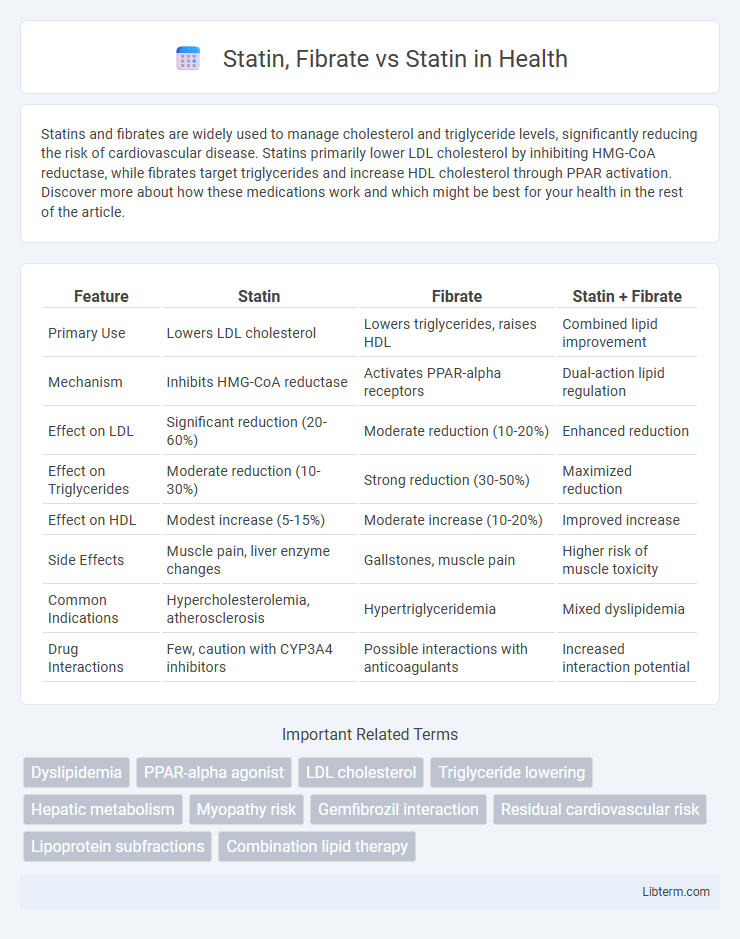Statins and fibrates are widely used to manage cholesterol and triglyceride levels, significantly reducing the risk of cardiovascular disease. Statins primarily lower LDL cholesterol by inhibiting HMG-CoA reductase, while fibrates target triglycerides and increase HDL cholesterol through PPAR activation. Discover more about how these medications work and which might be best for your health in the rest of the article.
Table of Comparison
| Feature | Statin | Fibrate | Statin + Fibrate |
|---|---|---|---|
| Primary Use | Lowers LDL cholesterol | Lowers triglycerides, raises HDL | Combined lipid improvement |
| Mechanism | Inhibits HMG-CoA reductase | Activates PPAR-alpha receptors | Dual-action lipid regulation |
| Effect on LDL | Significant reduction (20-60%) | Moderate reduction (10-20%) | Enhanced reduction |
| Effect on Triglycerides | Moderate reduction (10-30%) | Strong reduction (30-50%) | Maximized reduction |
| Effect on HDL | Modest increase (5-15%) | Moderate increase (10-20%) | Improved increase |
| Side Effects | Muscle pain, liver enzyme changes | Gallstones, muscle pain | Higher risk of muscle toxicity |
| Common Indications | Hypercholesterolemia, atherosclerosis | Hypertriglyceridemia | Mixed dyslipidemia |
| Drug Interactions | Few, caution with CYP3A4 inhibitors | Possible interactions with anticoagulants | Increased interaction potential |
Introduction to Statins and Fibrates
Statins are lipid-lowering medications that inhibit HMG-CoA reductase, effectively reducing LDL cholesterol and cardiovascular risk. Fibrates primarily activate PPARa receptors, targeting triglyceride reduction and modestly increasing HDL cholesterol. Combining statins with fibrates can enhance lipid profile management but requires careful monitoring for potential drug interactions and side effects.
Mechanism of Action: Statins vs Fibrates
Statins primarily inhibit HMG-CoA reductase, the key enzyme in cholesterol biosynthesis, reducing LDL cholesterol levels and upregulating LDL receptors on hepatocytes for enhanced clearance. Fibrates activate peroxisome proliferator-activated receptor-alpha (PPAR-a), which increases the oxidation of fatty acids and enhances lipoprotein lipase activity, predominantly lowering triglycerides and raising HDL cholesterol. The distinct mechanisms explain the preferential use of statins for LDL management and fibrates for hypertriglyceridemia treatment.
Indications: When to Use Statins and Fibrates
Statins are primarily indicated for lowering low-density lipoprotein cholesterol (LDL-C) in patients with hypercholesterolemia, atherosclerotic cardiovascular disease, and familial hypercholesterolemia. Fibrates are mainly prescribed for patients with hypertriglyceridemia and mixed dyslipidemia, particularly when triglyceride levels exceed 500 mg/dL to reduce the risk of pancreatitis. Statin-fibrate combination therapy may be considered in cases of combined lipid abnormalities, but individual drug indications guide initial treatment choices.
Lipid Profile Effects: Statins vs Fibrates
Statins primarily target LDL cholesterol reduction, effectively lowering total cholesterol and moderately increasing HDL cholesterol, while fibrates mainly decrease triglycerides and significantly raise HDL cholesterol levels. Combining statins with fibrates can enhance overall lipid profile improvement but requires careful monitoring due to increased risk of myopathy. Clinical studies highlight statins as first-line therapy for atherogenic dyslipidemia, whereas fibrates are preferred for hypertriglyceridemia and low HDL cholesterol management.
Cardiovascular Outcome Evidence
Statin therapy consistently demonstrates robust cardiovascular outcome benefits by significantly reducing LDL cholesterol and lowering the risk of major adverse cardiovascular events (MACE), including myocardial infarction and stroke. Fibrates primarily target triglycerides and HDL cholesterol but exhibit mixed evidence regarding their impact on cardiovascular outcomes, often showing limited additional benefit when combined with statins. Meta-analyses indicate that statin monotherapy remains superior to fibrate-statin combination therapy in reducing cardiovascular mortality and improving long-term prognosis in patients with atherosclerotic cardiovascular disease.
Common Side Effects and Safety Profile
Statins commonly cause muscle pain, increased liver enzymes, and digestive issues, while fibrates often lead to gastrointestinal discomfort, gallstones, and increased risk of muscle toxicity when combined with statins. The safety profile of statins is generally well-established with rare severe adverse effects, whereas fibrates carry a higher risk of drug interactions and potential kidney dysfunction. Monitoring liver function and muscle symptoms is crucial in patients using statins alone or in combination with fibrates to minimize adverse outcomes.
Drug Interactions and Contraindications
Statins combined with fibrates increase the risk of myopathy and rhabdomyolysis, particularly with gemfibrozil due to inhibited statin metabolism via CYP3A4. Contraindications for statin-fibrate therapy include pre-existing liver disease, severe renal impairment, and concurrent use of potent CYP3A4 inhibitors, which exacerbate adverse effects. Careful monitoring of liver enzymes and creatine kinase levels is essential to prevent serious drug interactions and contraindications.
Combination Therapy: When are Both Prescribed?
Combination therapy involving statins and fibrates is often prescribed for patients with mixed dyslipidemia characterized by elevated triglycerides and low HDL cholesterol, especially when statins alone do not achieve lipid targets. This approach aims to maximize lipid-lowering effects by addressing both LDL cholesterol reduction through statins and triglyceride lowering via fibrates, thereby reducing cardiovascular risk. Careful monitoring is essential due to an increased risk of muscle toxicity such as rhabdomyolysis when combining these medications.
Considerations in Special Populations
Statin therapy requires careful dose adjustments in elderly patients due to increased risk of myopathy and potential drug interactions with commonly prescribed medications. Fibrates, when combined with statins, elevate the risk of rhabdomyolysis, especially in patients with renal impairment or those with pre-existing hepatic dysfunction. Special populations such as patients with diabetes or metabolic syndrome benefit from statin use over fibrates because of statins' proven cardiovascular risk reduction and safer lipid profile management.
Conclusion: Choosing Between Statins and Fibrates
Statins primarily lower LDL cholesterol and reduce cardiovascular risk, while fibrates effectively decrease triglycerides and raise HDL cholesterol. The choice between statins and fibrates depends on the patient's lipid profile and cardiovascular risk factors, with statins preferred for atherosclerotic cardiovascular disease prevention and fibrates used when hypertriglyceridemia predominates. Combination therapy may be considered in cases of mixed dyslipidemia but requires careful monitoring for potential drug interactions and side effects.
Statin, Fibrate Infographic

 libterm.com
libterm.com